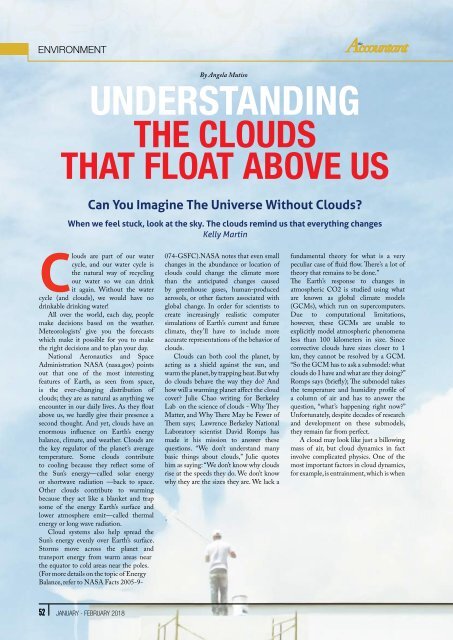The-Accountant-Jan-Feb-2018
Create successful ePaper yourself
Turn your PDF publications into a flip-book with our unique Google optimized e-Paper software.
ENVIRONMENT<br />
By Angela Mutiso<br />
UNDERSTANDING<br />
THE CLOUDS<br />
THAT FLOAT ABOVE US<br />
Can You Imagine <strong>The</strong> Universe Without Clouds?<br />
When we feel stuck, look at the sky. <strong>The</strong> clouds remind us that everything changes<br />
Kelly Martin<br />
Clouds are part of our water<br />
cycle, and our water cycle is<br />
the natural way of recycling<br />
our water so we can drink<br />
it again. Without the water<br />
cycle (and clouds), we would have no<br />
drinkable drinking water!<br />
All over the world, each day, people<br />
make decisions based on the weather.<br />
Meteorologists’ give you the forecasts<br />
which make it possible for you to make<br />
the right decisions and to plan your day.<br />
National Aeronautics and Space<br />
Administration NASA (nasa.gov) points<br />
out that one of the most interesting<br />
features of Earth, as seen from space,<br />
is the ever-changing distribution of<br />
clouds; they are as natural as anything we<br />
encounter in our daily lives. As they float<br />
above us, we hardly give their presence a<br />
second thought. And yet, clouds have an<br />
enormous influence on Earth’s energy<br />
balance, climate, and weather. Clouds are<br />
the key regulator of the planet’s average<br />
temperature. Some clouds contribute<br />
to cooling because they reflect some of<br />
the Sun’s energy—called solar energy<br />
or shortwave radiation —back to space.<br />
Other clouds contribute to warming<br />
because they act like a blanket and trap<br />
some of the energy Earth’s surface and<br />
lower atmosphere emit—called thermal<br />
energy or long wave radiation.<br />
Cloud systems also help spread the<br />
Sun’s energy evenly over Earth’s surface.<br />
Storms move across the planet and<br />
transport energy from warm areas near<br />
the equator to cold areas near the poles.<br />
(For more details on the topic of Energy<br />
Balance, refer to NASA Facts 2005-9-<br />
074-GSFC).NASA notes that even small<br />
changes in the abundance or location of<br />
clouds could change the climate more<br />
than the anticipated changes caused<br />
by greenhouse gases, human-produced<br />
aerosols, or other factors associated with<br />
global change. In order for scientists to<br />
create increasingly realistic computer<br />
simulations of Earth’s current and future<br />
climate, they’ll have to include more<br />
accurate representations of the behavior of<br />
clouds.<br />
Clouds can both cool the planet, by<br />
acting as a shield against the sun, and<br />
warm the planet, by trapping heat. But why<br />
do clouds behave the way they do? And<br />
how will a warming planet affect the cloud<br />
cover? Julie Chao writing for Berkeley<br />
Lab on the science of clouds - Why <strong>The</strong>y<br />
Matter, and Why <strong>The</strong>re May be Fewer of<br />
<strong>The</strong>m says; Lawrence Berkeley National<br />
Laboratory scientist David Romps has<br />
made it his mission to answer these<br />
questions. “We don’t understand many<br />
basic things about clouds,” Julie quotes<br />
him as saying: “We don’t know why clouds<br />
rise at the speeds they do. We don’t know<br />
why they are the sizes they are. We lack a<br />
fundamental theory for what is a very<br />
peculiar case of fluid flow. <strong>The</strong>re’s a lot of<br />
theory that remains to be done.”<br />
<strong>The</strong> Earth’s response to changes in<br />
atmospheric CO2 is studied using what<br />
are known as global climate models<br />
(GCMs), which run on supercomputers.<br />
Due to computational limitations,<br />
however, these GCMs are unable to<br />
explicitly model atmospheric phenomena<br />
less than 100 kilometers in size. Since<br />
convective clouds have sizes closer to 1<br />
km, they cannot be resolved by a GCM.<br />
“So the GCM has to ask a submodel: what<br />
clouds do I have and what are they doing?”<br />
Romps says (briefly); <strong>The</strong> submodel takes<br />
the temperature and humidity profile of<br />
a column of air and has to answer the<br />
question, “what’s happening right now?”<br />
Unfortunately, despite decades of research<br />
and development on these submodels,<br />
they remain far from perfect.<br />
A cloud may look like just a billowing<br />
mass of air, but cloud dynamics in fact<br />
involve complicated physics. One of the<br />
most important factors in cloud dynamics,<br />
for example, is entrainment, which is when<br />
52 JANUARY - FEBRUARY <strong>2018</strong>

















